Training on Indian ships a boon to naval cadets
By Ranil WIJAYAPALA
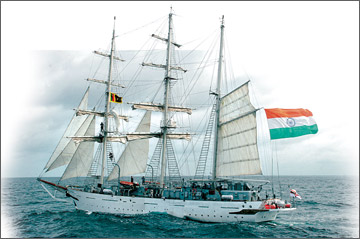
Sailing Ship the INS Tarangini
|
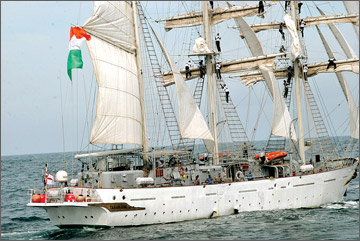 |
Miles of ropes connected to a large sheet of cloth designed to catch
the wind connected to the massive mast in the canter of the ship, may
baffle anyone who boarded this ship which was anchored in the Colombo
harbour last week.
Dozens of midshipmen of the Sri Lanka Navy climbed the mast to have a
first hand experience of catching the wind into the sails to propel the
ship forward using miles of ropes connected to the sails of INS
Tarangini-a Sailing Ship from the Indian Navy which arrived at the
Colombo harbour on a good will visit.
Using their hands they propelled the ship forward and manoeuvred it
in the sea struggling with the changing wind pattern and currents in the
sea.
It seems to be a rare and tiring experience for a naval cadet in his
path to become a career naval officer but is an essential part of his
training. “If you undergo your naval training at the prestigious
Dartmouth Naval and Martime Academy UK you may not be allowed to come
out of the camp unless you get the basic certificate in handling sailing
boats or ships.”
“We have to show the certificate to go out of the camp. That was an
essential qualification for a naval officer and there was no point of
becoming one without that essential qualification of handling a Sailing
Ship”, said Navy Commander Vice Admiral Thisara Samarasinghe recalling
his memories of handling Sailing Ships.
“I also underwent such training when training in UK 35 years ago. I
sailed to Cherbourg in France through the British channel using a 20
meter long Sailing Ship. I sailed from Dartmouth to Cherbourg and some
fishing harbours in the UK”, he added.
| Navy
Commander, Vice Admiral Thisara Samarasinghe says President
Mahinda Rajapaksa has given approval to the Sri Lanka Navy
to build its own ship to provide training to naval cadets as
it is a must for them to have training on board a Sailing
Ship.
The Navy Commander says that
the ship will be produced locally making use of the
expertise available with the Sri Lanka Navy. |
The Navy Commander is keen in providing that essential training which
he underwent as a naval cadet 35 years ago for the naval cadets of Sri
Lanka.
Officer cadets of the Sri Lanka Navy have no chance to go on a big
ship for that essential training. However, the arrival of ‘Tarangini’
provided the chance for 25 midshipmen of the Sri Lanka Navy to have that
training in the western seas of Colombo.
The opportunity was provided to them when four Indian naval ships,
INS “Tir”, INS “Shardul”, INS “Tarangini” and ICGS “Varuna” of the
Indian Naval 1st Training Squadron, arrived in Sri Lanka on October 9,
on a goodwill visit.
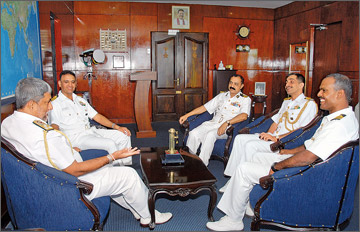
Commanding officers of the visiting Indian naval ships, Captain
Sanjeev Issar and Commanders AN Promod and Manish Sain with
Ddefence Advisor to the Indian High Commission in SL called on
the Commander of the Sri Lanka Navy, Vice Admiral Thisara
Samarasinghe at Naval Headquarters, Colombo. |
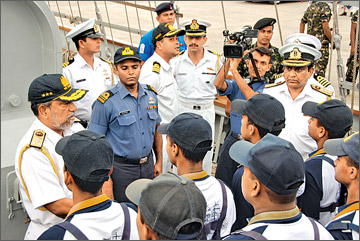
Navy Commander, Vice Admiral Thisara Samarasinghe addresses the
midshipmen in training on board the INS Tarangini. |
INS “Tir”, INS “Shardul” and ICGS “Varuna” arrived at the Port of
Trincomalee while INS “Tarangini” arrived at the Port of Colombo. They
were ceremonially welcomed in accordance with naval traditions.
While ‘Tarangini’ provided training in the Western seas the other
three Indian Naval Training Ships with SLN officer trainees on board
commenced sailing from the Port of Trincomalee to reach Colombo on
October 12.
Whilst sailing between Trincomalee and Colombo, the SLN officer
trainees had a practical training on a wide range of subjects
-seamanship, communication, coastal navigation, life saving,
replenishment at sea, fire fighting, damage control and anchoring.
The Sri Lanka Navy arranged a special program for the visiting
cadets.
The Indian cadets toured the Trincomalee Naval and Maritime Academy,
Sri Lanka Military Academy and the Sri Lanka Air Force Academy in
Diyatalawa during their stay in Sri Lanka.
“I grabbed the opportunity to provide our naval cadets to have this
training with the support of the Indian Navy. I am also trying to give
them training on board the small sailing boats available with us to
acquire knowledge”, he added.
Ships in the past sailed guided by the stars. The navies across the
globe must learn this ancient method although they have modern
technology and satellite systems to guide them in the sea.
“What I need to stress to our naval cadets through this training is
that they use their hands to tie a knot properly, to fix a rope
properly, things. That would help sailors save their lives at sea”, he
said. When ships are fixed with engines their manoeuvre is easy.
Currents change on a daily basis, seas can be stormy or calm. In
darkness or in day light, under rainy weather or under bright sunshine -
sailors should be prepared to work under all circumstances.
“We can’t go straight when we sailing. We must zigzag. The Captain of
the ship and the minors are equal. Leadership, team work and team spirit
should be with them”, the Navy Commander said.
“Physical toughness mental toughness out at sea makes you a great
personality.
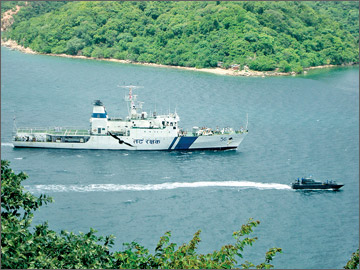
An Indian naval ship in Trincomalee. |
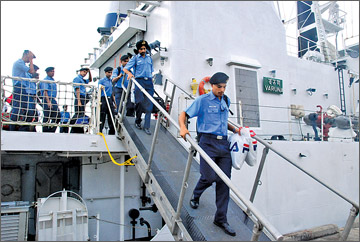
Indian naval cadets disembark. |
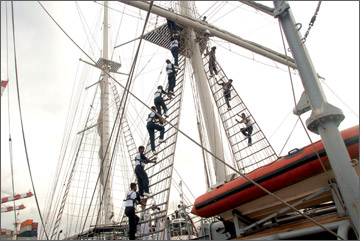
Naval cadets in training on board the INS Tarangini. |
Leadership blossoms when you are out at sea . When you are faced with
a problem out at sea you cannot retreat from your position. You have to
face the situation overcoming all odds”, he said.
“You cannot go against the tide. We have to move with the tide and
get to the required destination.
“The cradle of leadership is on the seas. If you can give leadership
to a group of people. There you can lead them on the ground more
effectively”, he said.
The Sri Lanka Navy must prepare itself to face post conflict
challenges.
“Protecting the shores of the country from drug traffickers,
monitoring and providing security for the boats going out to sea for
fishing and to protect maritime resources are the foremost challenges
before the Sri Lanka Navy. To do all these things we have need of
trained Naval officers”, he added.
The Navy Commander also said that the good relationship the Navies of
Sri Lanka and India maintain at present have been of mutually of
benefit.
“Through these type of training programs we invest for the future.
The relationship that developed during this joint Naval training will
help maintain bilateral relationship between the two countries”, he
added.
“The training reflects the goodwill, friendly relationships and
mutual co-operation that exist between the two friendly Navies”, he
added.
Commanding Officers of the visiting Indian Naval ships, Captain
Sanjeev Issar, Commander AN Promod and Commander Manish Sain called on
the Commander of the Sri Lanka Navy Vice Admiral Thisara Samarasinghe at
the Naval Headquarters in Colombo.
They were accompanied by Defence Adviser to the Indian High
Commission in Sri Lanka Captain Sumeet Kappor. |

